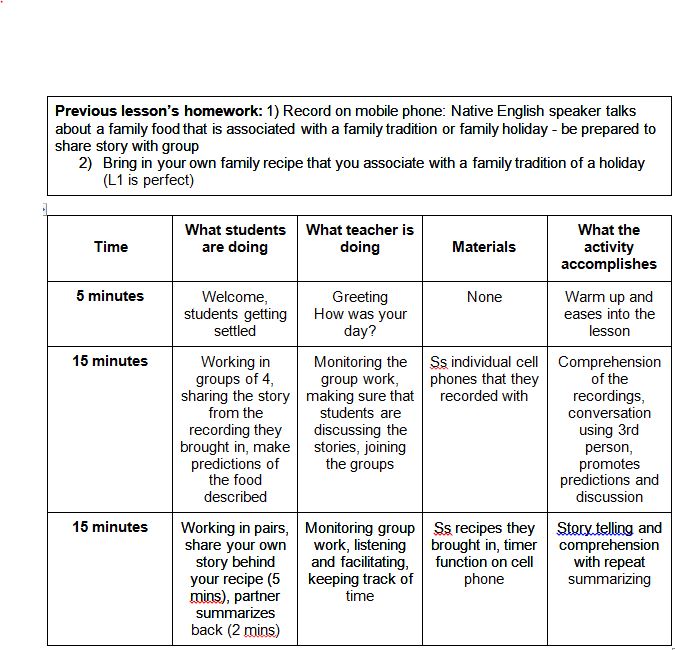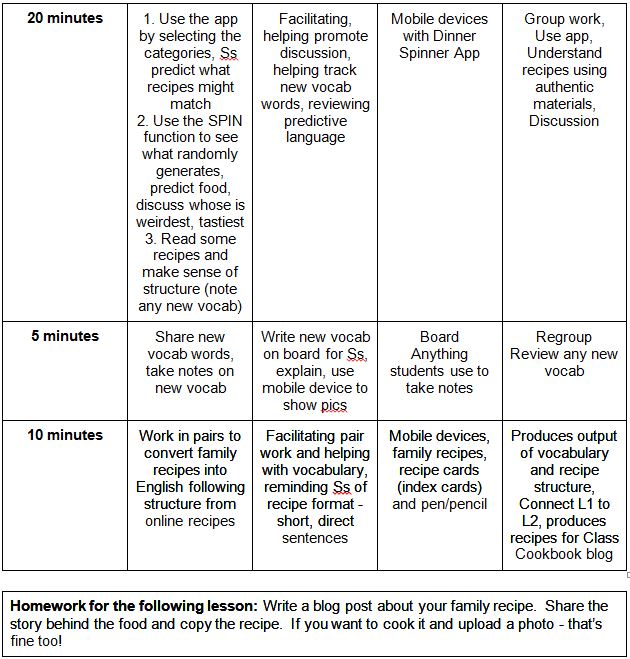Setting: Adult school, learners range from early 20s to 50s, intermediate level, various backgrounds and ethnicities living in the USA
Lesson context: The previous lessons have focused on food, different kinds of foods, traditional foods from various cultures, cultural and family traditions, how foods make us feel (good and bad). At the end of the unit there will be a food blog filled with posts of family traditions and recipes.
Language objectives: Describing and discussing foods, making predictions, storytelling, using third person and past tense to describe the person that was interviewed, learning cooking and recipe vocabulary and structure, translating family recipes into English, giving students real tools and understanding to use at home


Rationale
Mobile-Assisted Language Learning (MALL) is an important part of the language classroom environment in this generation. For several decades, computers have provided an open gateway between the classroom and the outside world. Mobile technology increases convenience and accessibility, in addition to portability which allows for an enhanced classroom, or even a flipped classroom helping to promote learner autonomy and motivation. With respect to language classes, we are not limited to apps specific to language learning and acquisition. With creativity, mobile technology can be a tool for language learning using the existing functionalities of the device itself as well as providing access to an infinite source of authentic material. Additionally, mobile devices can enhance pedagogy by making both the learners and the whole learning experience as mobile as the device itself (Pegrum, 2014).
My sample lesson uses the mobile device in a couple of different ways. The first is the use of the voice recorder, which is a standard function of most smart phones. The voice recorder allowed students to go out into the community and interview native speakers, collecting real speech samples, which made the learning experience mobile. This is not a novel idea, however. According to Puentedura’s (2011) SAMR model of technology as an enhancement (substitution / augmentation) or transformation (modification / redefinition) of a task , the voice recorder is a convenient substitution for the use of a portable cassette recorder. The files are also easily stored and accessed for use in class and the quality of sound is much greater.
Another way in which the mobile device was used in class was through the use of internet search engines. The scavenger hunt makes use of the Involvement Load Hypothesis – especially looking at the need-search aspects regarding vocabulary acquisition. Hulstijn and Laufer (2001) found in their research that vocabulary tasks with a higher level of “involvement load” created a greater frequency of retention. Looking deeper into the activity, what affordances does the mobile device offer over using a desktop computer, or even a laptop? Students are already comfortable with their own smart phones which allows for quick searching in the scavenger hunt. It also keeps the students mobile for the activity so they can easily return to “home-base” and collect their next word. The technology aspect could be boosted by having the students upload the pictures they find online into an instagram account under a hashtag, but I like the idea of having the students active and mobile during the activity. I wanted the activity to be about the internet word search and the fun of the game, and less about the overuse of technology in this case. An addition to the lesson could be to have time built in for the students to upload all those photos under a class hashtag for quick referencing later. I did build in time after the activity for reviewing the vocabulary, and students are encouraged to take notes in any way that works best for them: traditional paper and pen/pencil, a note-taking app on their device (enhancing the note-taking process), or even hashtagging the photos into their instagram accounts (redefining and transforming the note-taking process).
Lastly, following Puentedura’s (2011) SAMR model, focusing on technology enhancing the conversation task, I chose to use the Allrecipes Dinner Spinner app. This app provides authentic materials in the forms of recipes and recipe reviews in a fun, roulette-style manner. By using this app, the mobile devices provides content delivery in a creative way which is then used to promote conversation. Students can see the previously studied vocabulary words in real context. The app also allows for students to make predictions on what recipes might come out of the “spin”, additionally discussing the recipes and their thoughts about them. The students’ thoughts can then be compared to thoughts of other native speakers by reading reviews. This app provides the students with material for practical usage at home, as well.
Towards the end of the lesson, students are encouraged to work together to write their family recipe into the correct format from the samples they found in the app. At the same time, students will be writing a brief family story behind their recipe (relating to their culture or a specific family tradition). The students will be entering these into the class blog for homework. This provides a nice online takeaway for the students promoting both pride and diversity with regards to their traditions and recipes.
The affordances of MALL in the sociocultural ecosystem are visible in the previously mentioned blog activity – giving the students pride in their own cultural traditions and family recipes, as well as displaying diversity by making them familiar with the various cultural backgrounds and those relationships to different foods. The Dinner Spinner app also displays recipes that are culturally diverse which students will be able to discuss. The use of the voice recorder for the interview also allows the students to collect real data from native speakers of English providing an even greater scope of diversity with exposure to authentic perspectives of American (or other) family traditions and foods.
Both the recorded interview and the Dinner Spinner app fit into the linguistic ecosystem, as well, by putting the language into immediate context and use for both input and output. Authentic materials also help to identify vocabulary and grammar in real context. The internet scavenger hunt provides word and picture association in a tangible way, which helps students remember it by trying to find it (Involvement Load Hypothesis), therefore aiding in acquisition.
Other ways in which the mobile devices and apps fit into the acquisitional ecosystem are by allowing for constant and sustainable input that is both authentic and practical. This input from the mobile device allows the classroom to be extended to the students’ homes and out into the real world, which is also a great affordance in the pedagogical ecosystem. Similarly, it allows the students to be mobile, themselves, in classroom activities (such as the internet scavenger hunt) instead of being stuck at a desk or behind a computer.
This lesson fits into the technological ecosystem in a variety of ways. The mobile device is being used to conduct an interview using the voice recording function. This does not require the internet, so it can be done anywhere. The other activities, however, do require the internet which means that the lesson could easily break down if the internet is not functioning properly. The lesson would need to be modified if the internet were to fail. Should the internet cause no interference in the lesson, the supplemental resources for this lesson are minimal as they are built into the students’ personal mobile devices.. Within the institutional ecosystem, it is a good argument for MALL bringing efficient and effective, real-world materials into the classroom with a minimal cost.
In this sample lesson I have tried to design tasks enhanced by technology providing contextual materials with real world application for the students. The use of technology adds to the creativity of the classroom environment, hopefully adding to student motivation. Pegrum (2014) makes mention that a project and a classroom can be successful when when they blend pedagogies with contextual readiness while giving the students active roles. MALL provides the language-learning classroom with infinite possibilities for enhancing, and potentially transforming the student experience.
References
Hulstijn, J. H., & Laufer, B. (2001). Some empirical evidence for the involvement load hypothesis in vocabulary retention. Language Learning, 51(3), 539-558.
Pegrum, M. (2014). Mobile learning: Language, literacies, and cultures. Hampshire, UK: Palgrave Macmillan.
Puentedura, R.r. (2011). SAMR and TPCK in action [PowerPoint slides]. Retrieved from http://www.hippasus.com/rrpweblog/archives/2011/10/28/SAMR_TPCK_In_Action.pdf


